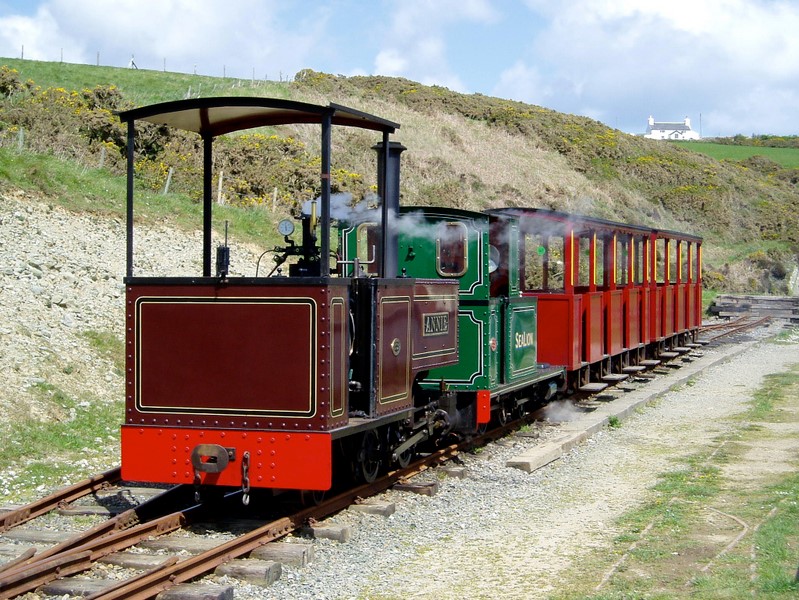|
A BRIEF HISTORY
It was the popularity of the Isle of Man as a Victorian
tourist resort with vast numbers of visitors, largely thanks
to better social conditions and transport links both within
the United Kingdom and to and from the Island, that caused
numerous attractions to be constructed, each in their own
way catering for the addition to the Manx economy. One such
project was sited at Groudle Glen, just north of Douglas and
which soon proved popular enough to warrant the need for
some form of system to transport the crowds through the
glen.
In 1896 a steam-operated railway line was constructed
linking the inner glen at Lhen Coan with the attractions on
the coast at Sea Lion Rocks, a distance of approximately
three quarters of one mile. Despite the relative short
length of the new line, a vast array of different scenic
vistas was offered to the passenger, ranging from charmed
inland glen views, which becmae very wooded in appearance as
foliage became more established, through to spectacular
coastal scenery, much beloved during the Victorian era.
Two stations were provided, one at each end of the line -
Lhen Coan and Sea Lion Rocks - whilst track was of 2' gauge
comprising lightweight falt bottom rails. Single-line
throughout, a passing loop was later installed on the
headland, about two-thirds of the way along the line, which
allowed the simultaneous operation of two trains. An initial
2-4-0 tank locomotive was purchased from the engineering
works of WG Bagnell and was given the name
SEA LION after one of the animal attractions found
at the coastal end of the line. Patronage soon increased to
the point that a second similarly constructed locomotive was
added in 1905 and named POLAR BEAR. Aside from a short
period during the early 1920's, when motive power was
provided by two battery-electric locomotives, these two
steam engines continued to operate peacetime services until
the railway closed.
With the Manx tourist industry coming to an abrupt halt as a
result of the Second World War services were suspended for
the duration and when the railway reopened afterwards it was
operating over a shortened section between Lhen Coan and the
Headland. Throughout the 1950's both the Glen and railway,
in line with the Manx tourist industry generally, fell prey
to diminishing numbers of visitors and by the early 1960's
it had become uneconomic, despite strenuous efforts by
management and staff to see it continue. Attempts to repairs
POALR BEAR, by then the sole operataional engine - or
find a suitable replacement for the 1963 season failed and
the line effectively closed at the end of the 1962 summer
season, after which it was largely dismantled.
Some twenty years after the line closed the Isle of Man
Steam Railway Supporters Association were seeking an avenue
to channel its energies and, after looking at a number of
options, the decision was taken to try and restore the line
at Groudle. From 1982 the former track bed was cleared and
in October that year eight 4-wheel former RAF bomb
wagons were acquired for various uses during the line's
reconstruction. Track laying started in May 1983 over the
Headland - Lhen Coan section and two second-hand
Hudson-Hunslett diesel locomotives & other items of
rolling stock were purchased from a closed line at
Doddington House, with the first passenger train being
operated between Lime Kiln Halt & Headland during
December. Reconstruction continued over the next couple of
years and had reached a point that regular operation between
Lhen Coan and Headland could recommence on Sunday, May 25,
1986. The following year saw the return of the railway's
original locomotive SEA LION, which had undergone a
complete rebuild by BNFL, Sellafield. Continued efforts saw
the line extended to its original length, with the Headland
- Sea Lion Rocks section being re-opened in May 1992.
Improvements to the railway and its facilities are
continually being undertaken and it has been host to a range
of visiting locomotives, including former GGR engine
POLAR BEAR, now resident at the Amberley Chalk Pits
Museum. Santa & Mince Pie special trains are
amongst the annual railway calendar, indeed this was the
first line on the Island to offer the facility and trains
normally operate on each Sunday and certain Saturdays
daytime/Wednesday evenings throughout the summer.
|




